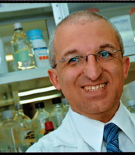Scientific Program

Technical University Munich, Germany

General Hospital Klagenfurt, Austria

University of Modena and Reggio Emilia, Italy
Lorenzo Corsia, Maria Chiara Montib, Francisco J. Ruperezc, Antonia Garciac, Federica Pellatia
a Department of Life Sciences, University of Modena and Reggio Emilia, via Giuseppe Campi 103-287, 41125, Modena, Italy
b Department of Pharmacy, University of Naples ‘Federico II’, Via Tommaso De Amicis 95, 80131 Naples, Italy
c Center for Metabolomics and Bioanalysis (CEMBIO), Faculty of Pharmacy, San Pablo-CEU University, Campus Monteprincipe, Boadilla del Monte 28668 Madrid (Spain)
Background: In recent years, an increasing number of studies have described the broad spectrum of biological activities of Cannabis sativa L. extracts and cannabinoids, including the possible anticancer effect by several molecular mechanisms, such as inhibition of proliferation, angiogenesis and metastatic processes.
Objectives: This study aimed to assess the antiproliferative activity of chemically characterized extracts from non-psychoactive C. sativa (hemp) and to disclose the possible mechanism/s of action of the main cannabinoids.
Methods: For what concerns cannabinoids, hemp extracts from different plant varieties were analyzed by ultra high-performance liquid chromatography coupled with high-resolution mass spectrometry (UHPLC-HRMS), and the compounds were quantified using HPLC-UV. The antiproliferative activity of the extracts was assessed in vitro against a panel of human cancer cell lines. To shed light on the cannabidiol (CBD) apoptotic mechanism of action, a functional proteomic study based on “Drug Affinity Responsive Target Stability” (DARTS) was performed to identify its interactome in chronic myelogenous leukemia K562 cells, which were the most sensitive ones to the treatment. Finally, a lipidomic study was conducted to disclose the metabolic changes that occurred in the cellular lipid pattern of K562 cells following treatment with CBD to determine significant alterations of the cell metabolism attributable to the induction of apoptosis.
Results: A CBD-type hemp extract was able to inhibit cell proliferation in a dose-dependent manner and induce apoptosis via caspase 3 and 7 activation. A significant decrease in the mitochondrial membrane potential was detected, together with the release of cytochrome c in the cytosol. DARTS indicated that CBD apoptotic effects on K562 cell lines may be due to its ability to affect the GTPase activity of EFTUD2. The comprehensive characterization of the changes in the lipid metabolism in K562 cancer cells treated with CBD unveiled several classes affected by the compound, including cardiolipins (CL), phosphatidylcholines (PC), triacylglycerols (TG) and phosphosphingolipids (SM).
Conclusion: Even if further work is necessary to validate the results on different cell lines, the present research supports CBD as a possible candidate for future therapy of myeloproliferative diseases alone or in association with other anticancer drugs.

Trinity College Dublin, Ireland

Maj Institute of Pharmacology, Polish Academy of Sciences, Poland

Medical Cannabis Patients Association, Spain

Imperial College Healthcare NHS Trust, UK

Institute of Pain Medicine, Tel Aviv Medical Center, Israel

National Institute of Health, Italy
National Center for Drug Research and Evaluation, National Institute of Health, Italy
Background. Since 2015, Cannabis for medical use is reimbursed in Italy within the National Health Service for persons with specific clinical conditions, including analgesia in chronic pain and conditions involving pain-associated spasticity (e.g. multiple sclerosis) resistant to conventional therapies.
Objective. To describe prescriptions of Cannabis for medical use during the period from January 2016 to February 2024.
Methods. An ad hoc web monitoring system was created to collect prescriptions issued in Italy. Physicians fill out prescription forms reporting data on the prescribed product, initiation and duration of therapy, daily dosage, number of daily administrations, route of administration, and clinical conditions.
Results. In the study period, 114,422 prescriptions, related to 36,728 patients were registered. The median age of patients was 59 years (IQR 48-71), with women represented 67% of the total. The 41-60 age group accounted for 41.8% of the total, and on average, each user received 3.1 prescriptions. Regarding the type of Cannabis prescribed, Bedrocan® and Bediol®, with 50,581 (44.2%) and 37,029 (32.4%) prescriptions, respectively, were the most widely used. Cannabis was mainly prescribed for chronic pain, spasticity in multiple sclerosis and antikinetic and antiemetic effect in nausea and vomiting, following chemotherapy. Dosages were highly variable, with a median daily dose of 185 mg (25°-75° percentile: 74-374 mg) for chronic pain. In nearly all prescriptions (80%), cannabis was used as an add-on therapy.
Conclusion. Our data provide a detailed description of the characteristics of medical cannabis users in Italy in terms of the products prescribed, dosages, and reasons for use.

General Hospital Klagenfurt, Austria

Medical Cannabis Trade Association, France

Prague University Hospital FNKV, Czech Republic

University of Kiel, Germany

Tel Aviv Medical Center, Israel

Werner Wicker Clinic, Germany

Quirónsalud Hospital, Spain

Association for Cannabis Therapy PACT, Poland

University of Oslo, Norway
Andras Bilkei-Gorzo, Institut of Molecular Psychiatry, University Clinics Bonn, Germany
Dariusz Myrcik, Urszula Michalik-Marcinkowska, Gustino Varrassi, Aleksandra Kiełtyka-Słowik, Poland
Matilde Marani, Virginia Brighenti, Federica Pollastro, Caterina Durante, Giuseppe Cannazza, Federica Pellati, Italy

University of Oslo, Norway

Hadassah Hebrew University Medical Center, Israel

Institute of Pain Medicine, Tel Aviv Medical Center, Israel

Imperial College Healthcare NHS Trust, UK

University of Oslo, Norway

Quirónsalud Hospital, Spain
